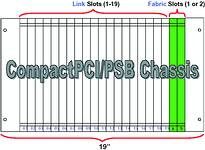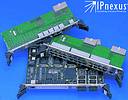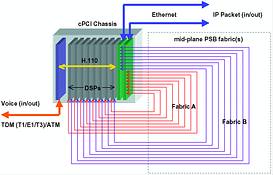
Systematic Designs, a value added-reseller and distributor specialising in offering real-time solutions to customers, describes the latest technology for the telecoms industry - 'packet-switched Ethernet over CPCI'.
CompactPCI/PSB is an extension to the PCI Industrial Computer Manufacturers Group (PICMG 2.x) family of specifications that overlays a packet-based switching architecture on top of CompactPCI to create an Embedded System Area Network (ESAN). It supplements the robust and reliable hot-swap capable CompactPCI architecture with the easily integrated, low-cost, high-performance, and extensible Ethernet. This creates a platform well suited to the integration of components for demanding systems and empowers system integration and design to ascend to higher layers of the Open Systems Interconnection (OSI) protocol stack, thus reducing system integration time.
The PICMG 2.16 CompactPCI/PSB specification was developed by Performance Technologies last year, and was ratified by PICMG on 5 September this year.
CompactPCI/PSB (PICMG 2.16) provides the ideal solution for next-generation applications. CPSB increases performance by moving data traffic off the shared bus, and onto an embedded switched Ethernet network fabric (10/100/1000 Mbit/s), accessed via the J3 connector on the CPCI backplane. It leaves the H.110 telephony bus intact for systems that support this standard. Components that support CPSB can be mixed with units that still rely on the CompactPCI bus for communication within the same chassis. CompactPCI/PSB is the latest in high-bandwidth network interfaces that have been designed and can support transfer rates of up to 2,8 Gbps.
A packet-switching backplane is composed of node slots, fabric slots, and the links that interconnect them. The PSB topology is a star (not a bus). Each line interconnecting a node slot and fabric slot represents a link that is a 10/100/1000 Mbps full-duplex Ethernet connection. Node boards communicate by transferring/receiving packets to/from the Fabric Board, which transfers the packet to/from one or more node boards. Thus, every node board can communicate with every other node board and form a fabric. A PSB backplane can have up to 20 node slots (with one or two link ports) per chassis; and up to two fabric slots.
The objectives of CompactPCI/PSB are: reduce integration time; increase system reliability; improve density/performance; enhance existing CompactPCI; provide architectural scalability; leverage ubiquity of IP/Ethernet.
The PICMG2.16 specification allows for two fabric slots and up to 19 node slots. The CPSB chassis in Figure 1 displays the fabric and node slot configuration. The node slots and fabric slots are wired in a dual-redundant star topology on the backplane, allowing each node to connect to two independent embedded Ethernet switches located in the fabric slots over the backplane by means of a star topology. In addition to the dual Ethernet networks on the backplane each node slot can interface over the traditional 32/64 bit CPCI backplane.
Each node slot can be populated with a high-performance single board computer, such as the Concurrent Technologies' PP CP1/P3x. PP CP1/P3x products are currently available with Socket 370 Pentium III processors with 1 GHz and more. Each fabric slot can be populated with an embedded Ethernet switch, such as the Performance Technologies' CPC4400 or the CPC3400. The CPC4400 is a 24 x 10/100BT and 2 x 1000BT embedded Ethernet switch.

Embedded Ethernet switch
Performance Technologies' embedded Ethernet switches are used in one or both of the fabric slots in a CompactPCI/PSB system. One of the embedded Ethernet switches is the CPC4400. The CPC4400 is the first CompactPCI switch compliant with the CompactPCI packet-switching backplane standard (PICMG 2.16). Performance Technologies' CPC4400 are fast, flexible and feature-rich 10/100/1000 auto-negotiating Ethernet ports plus two Gigabit ports in a rugged, hot-swap CompactPCI 6U form factor (Figure 2).

Features include:
* Wire-speed Layer 2/Layer 3 (IP) switching at around 9 Gbps (over 6,6 million packets/s with latencies less than 4 ms).
* Layer 4-7 filtering (increased security and improved packet classification).
* Link aggregation and VRRP (increases network speed and availability).
* Support for multiple switching architectures.
* Support for IEEE 802.1p class of service (ensures delay-sensitive traffic receives the priority it deserves).
* Easy-to-use 802.1q VLANs (allows creation of virtual channels that span the entire network).
* Prevents broadcast, multicast and unicast storms (uses threshold detection and suppression).
* No configuration required (simply install additional nodes in chassis to increase switching capacity).

SBC based on PICMG 2.16
Concurrent Technologies' latest high-performance CompactPCI system slot controller - the PP CP1/P3x - introduces the latest standard of PICMG2.16 (packet-switching backplane) which is an ideal introduction to switched fabric applications, and IPMI (Intelligent Platform Management Interface). As a system controller, the PP CP1/P3x supports PICMG 2.1 hot-swap specification. The board can also be used in satellite mode (standalone mode) for applications not requiring the CompactPCI backplane except for providing power.
Featuring up to 1 GHz+ Pentium III processor and up to 1 GB DRAM within a single slot, this board suits a variety of applications, including those requiring long life availability, configuration control, and high reliability. At the core of the design is the Socket 370 Pentium III, which supports 100 MHz bus, and 256 KB of high-speed secondary cache. For increased reliability, heatsinks are used in preference to fans for cooling the CPU, whilst maintaining a single-slot solution.
The board provides a minimum of 512 MB of S-DRAM which can be upgraded to 1 GB using standard off-the-shelf DRAM modules. EIDE is supported and an optional on-board 2,5" disk drive is available. Alternatively, one or two CompactFlash modules can be installed. In addition, 8 MB of application flash memory is provided.
Two Fast Ethernet channels are provided using Intel 82599ER devices and each channel supports 10Base-T and 100 Base-TX. The channels are individually switchable between the front panel RJ45 connectors and rear connectors. Support is also provided for PICMG 2.16 packet-switching backplane.
Two RS232 serial channels are provided, together with a graphics interface with AGP support using the Asiliant 69030 device. Other interfaces include keyboard and mouse interface, PC realtime clock, two USB interfaces, parallel printer, watchdog timer, system fan monitor and speaker interface. The board's features can be further customised to suit the user's application by the addition of a PMC module. An optional transition module is also available. For ease of integration, the PP CP1/P3x supports many of today's leading operating systems, including Linux, QNX, VxWorks, and WinNT/2000.
For further information contact Sean van der Walt, Systematic Designs, (021) 555 3866, [email protected], www.systematic.co.za

© Technews Publishing (Pty) Ltd | All Rights Reserved